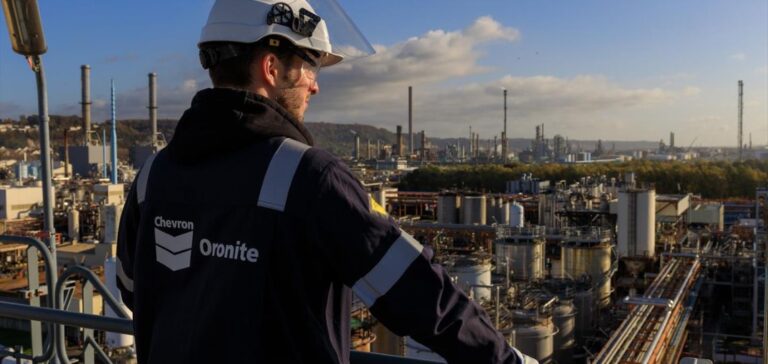Chevron sees its commitments to purchase U.S. LNG volumes under a series of long-term agreements with U.S. exporters as helping to lay the foundations for an Atlantic Basin LNG portfolio that the oil and gas giant aims to build over the next few years. Chevron executives told S&P Global Commodity Insights.
US LNG market: Chevron opts for long-term contracts rather than direct investment
But the integrated major’s preference for signing long-term contracts with US LNG developers rather than taking a direct stake in a project or building its own facility marks a paradigm shift from the strategy that has made Chevron a major LNG player in the Pacific, where it operates the Gorgon and Wheatstone projects.
Chevron’s foray into the US LNG sector also reflects a different approach to that of its peers, including ExxonMobil, ConocoPhillips and TotalEnergies, all of whom have made major investments in new liquefaction facilities in the USA. Yet in the United States, Chevron is comfortable with its buy rather than build approach.
Chevron’s foray into the US LNG sector also reflects a different approach to that of its peers, including ExxonMobil, ConocoPhillips and TotalEnergies, all of whom have made major investments in new liquefaction facilities in the USA. Yet in the United States, Chevron is comfortable with its buy rather than build approach.
Chevron goes global with U.S. LNG contracts
Executives described Chevron’s contracts for LNG offtake in the U.S. as consistent with the company’s goals of selling more of its growing Permian Basin production to international markets. while leaving the development of the U.S. midstream infrastructure to third parties, as the company concentrates its investments upstream and downstream.
“We’ve really looked at building our own plants — and does it make sense in the U.S., to tie up our capital — but we have so many investment opportunities in the Permian,” Freeman Shaheen, Chevron’s president for global gas, said in a recent interview with a small group of journalists at the LNG2023 conference in Vancouver, British Columbia.
“We can drill in the Permian for decades. And so, when you look at capital, it has to compete.”
“This is the first time in my 33-year career that I’ve seen strategies really diverge between the major oil companies. This value, in our portfolio, is not competing now to be able to pull those dollars out.”
Purchase agreements After having remained absent during the previous wave of investment in LNG projects in the USA, in June 2022 Chevron signed four long-term sales and purchase agreements for a total of 4 million tons/year of supply with exporters Cheniere and Venture Global.
Chevron secures LNG deals with Cheniere and Venture Global in the U.S.
Under the SPAs, half of the volumes will come from the Sabine Pass LNG terminal in Cheniere, Louisiana, and the planned expansion of the Corpus Christi LNG plant in Cheniere, Texas. The other half would come from Venture Global’s Plaquemines liquefied natural gas facility under construction in Louisiana and the proposed CP2 LNG project in the state.
Transaction deliveries are scheduled to start in 2026, before ramping up to full volumes in 2027. According to John Kuehn, Chevron’s President of Supply and Trading, in a separate interview at the conference, the progress made by Cheniere and Venture Global is helping to diversify Chevron’s LNG supply and spread project risk.
Securing capacity provides an important outlet for Chevron’s gas production in the Permian Basin, where the company is one of the leading producers and holds some 2.2 million acres. Chevron executives, who said the company would continue to explore LNG opportunities in the U.S., also cited Cheniere and Venture Global’s status as existing U.S. exporters and the company’s commitments to emissions reductions as important factors in signing the agreements.
Chevron’s strategy to become a global LNG player
Beyond U.S. volumes, Chevron has significant gas positions in Equatorial Guinea and the Eastern Mediterranean, where the company and its partners have pursued an expansion of the Leviathan gas field offshore Israel, including a potential floating LNG project. Chevron also has a stake in the Angola liquefied natural gas project in West Africa.
“We can become a portfolio player in the Atlantic Basin and, consequently, a global portfolio player,” Kuehn said.
“We are building an LNG business at Chevron. At the highest level, we aspire for it to be similar to our crude oil and products business, where it contributes significantly to the monetization of our exchange gas, just as we do with crude oil and products, and it’s a global commercial portfolio.”
Third-party suppliers The Gorgon and Wheatstone projects, which came on stream in 2016 and 2018, experienced billions of dollars in cost overruns during their development, which could have limited Chevron’s desire to invest in other LNG megaprojects.
Chevron prefers to work with midstream experts for its LNG projects
But one of the reasons given by Chevron executives for contracting LNG capacity in the U.S. rather than building it is that in the U.S., a robust midstream sector means Chevron doesn’t have to build a major export project to develop its oil and gas reserves.
“We don’t invest much of our capital ourselves in the middle space,” Kuehn says.
“In the way we discipline capital, the best place to spend it, where it’s most competitive in our portfolio, is upstream or downstream. There are other people like Cheniere and Venture Global who are really the experts in this area. So we can deploy our commitments and their capital, and that fits our model.”
This is a major difference from Australia.
“We’ll generally go and use these third-party suppliers, but that wouldn’t stop us from making our own investment,” Kuehn said.
“If it’s the difference between ‘it stays in the ground’ or ‘it comes out faster’, it’s, again, where we’d be more likely to deploy our own capital.”






















